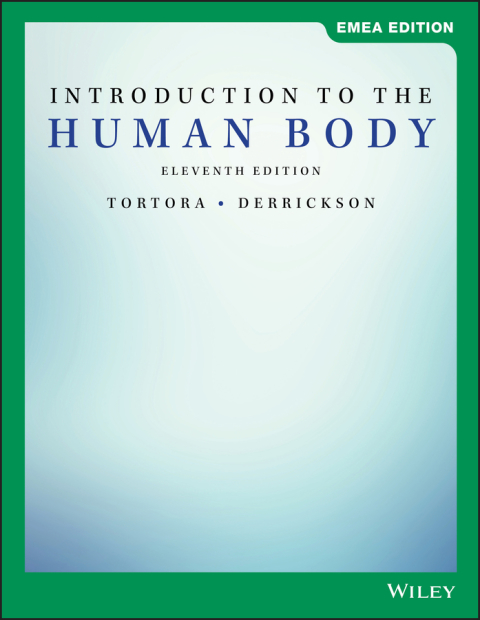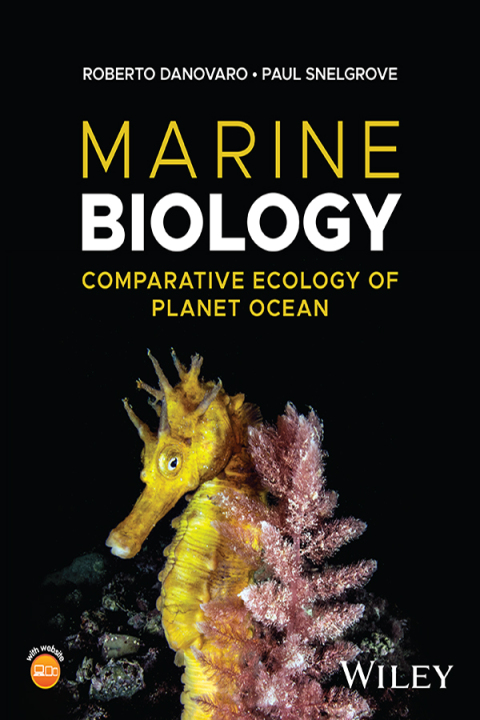Description
Efnisyfirlit
- Cover Page
- Title Page
- Copyright
- About the Authors
- Preface
- Acknowledgments
- Brief Contents
- Contents
- CHAPTER 1 Organization of the Human Body
- 1.1 Anatomy and Physiology: An Overview
- 1.2 Life Processes
- 1.3 Homeostasis: Maintaining Limits
- 1.4 Aging and Homeostasis
- 1.5 Anatomical Terms
- 1.6 Body Cavities
- Chapter Review
- Critical Thinking Applications
- Answers to Figure Questions
- CHAPTER 2 Introductory Chemistry
- 2.1 Introduction to Chemistry
- 2.2 Chemical Compounds and Life Processes
- Chapter Review
- Critical Thinking Applications
- Answers to Figure Questions
- CHAPTER 3 Cells
- 3.1 A Generalized View of the Cell
- 3.2 The Plasma Membrane
- 3.3 Transport Across the Plasma Membrane
- 3.4 Cytoplasm
- 3.5 Nucleus
- 3.6 Gene Action: Protein Synthesis
- 3.7 Somatic Cell Division
- 3.8 Cellular Diversity
- 3.9 Aging and Cells
- Chapter Review
- Critical Thinking Applications
- Answers to Figure Questions
- CHAPTER 4 Tissues
- 4.1 Types of Tissues
- 4.2 Epithelial Tissue
- 4.3 Connective Tissue
- 4.4 Membranes
- 4.5 Muscular Tissue
- 4.6 Nervous Tissue
- 4.7 Tissue Repair: Restoring Homeostasis
- 4.8 Aging and Tissues
- Chapter Review
- Critical Thinking Applications
- Answers to Figure Questions
- CHAPTER 5 The Integumentary System
- 5.1 Skin
- 5.2 Accessory Structures of the Skin
- 5.3 Functions of the Skin
- 5.4 Skin Wound Healing
- 5.5 Aging and the Integumentary System
- Chapter Review
- Critical Thinking Applications
- Answers to Figure Questions
- CHAPTER 6 The Skeletal System
- 6.1 Functions of Bone and the Skeletal System
- 6.2 Types of Bones
- 6.3 Structure of Bone
- 6.4 Bone Formation
- 6.5 Exercise and Bone Tissue
- 6.6 Divisions of the Skeletal System
- 6.7 Skull and Hyoid Bone
- 6.8 Unique Features of the Skull
- 6.9 Vertebral Column
- 6.10 Vertebral Regions
- 6.11 Thorax
- 6.12 Pectoral (Shoulder) Girdle
- 6.13 Upper Limb
- 6.14 Pelvic (Hip) Girdle
- 6.15 Lower Limb
- 6.16 Comparison of Female and Male Skeletons
- 6.17 Aging and the Skeletal System
- Chapter Review
- Critical Thinking Applications
- Answers to Figure Questions
- CHAPTER 7 Introductory Chemistry
- 7.1 Classification of Joints
- 7.2 Fibrous Joints
- 7.3 Cartilaginous Joints
- 7.4 Synovial Joints
- 7.5 Types of Movements at Synovial Joints
- 7.6 Types of Synovial Joints
- 7.7 The Knee Joint
- 7.8 Aging and Joints
- Chapter Review
- Critical Thinking Applications
- Answers to Figure Questions
- CHAPTER 8 The Muscular System
- 8.1 Overview of Muscular Tissue
- 8.2 Skeletal Muscle Tissue
- 8.3 Contraction and Relaxation of Skeletal Muscle
- 8.4 Metabolism of Skeletal Muscle Tissue
- 8.5 Control of Muscle Tension
- 8.6 Exercise and Skeletal Muscle Tissue
- 8.7 Cardiac Muscle Tissue
- 8.8 Smooth Muscle Tissue
- 8.9 Aging and Muscular Tissue
- 8.10 How Skeletal Muscles Produce Movement
- 8.11 Principal Skeletal Muscles
- Chapter Review
- Critical Thinking Applications
- Answers to Figure Questions
- CHAPTER 9 Nervous Tissue
- 9.1 Overview of the Nervous System
- 9.2 Histology of Nervous Tissue
- 9.3 Action Potentials
- 9.4 Synaptic Transmission
- Chapter Review
- Critical Thinking Applications
- Answers to Figure Questions
- CHAPTER 10 Central Nervous System, Spinal Nerves, and Cranial Nerves
- 10.1 Spinal Cord Structure
- 10.2 Spinal Nerves
- 10.3 Spinal Cord Functions
- 10.4 Brain
- 10.5 Cranial Nerves
- 10.6 Aging and the Nervous System
- Chapter Review
- Critical Thinking Applications
- Answers to Figure Questions
- CHAPTER 11 Autonomic Nervous System
- 11.1 Comparison of Somatic and Autonomic Nervous Systems
- 11.2 Structure of the Autonomic Nervous System
- 11.3 Functions of the Autonomic Nervous System
- Chapter Review
- Critical Thinking Applications
- Answers to Figure Questions
- CHAPTER 12 Somatic Senses and Special Senses
- 12.1 Overview of Sensations
- 12.2 Somatic Senses
- 12.3 Olfaction: Sense of Smell
- 12.4 Gustation: Sense of Taste
- 12.5 Vision
- 12.6 Hearing and Equilibrium
- Chapter Review
- Critical Thinking Applications
- Answers to Figure Questions
- CHAPTER 13 The Endocrine System
- 13.1 Introduction
- 13.2 Hormone Action
- 13.3 Hypothalamus and Pituitary Gland
- 13.4 Thyroid Gland
- 13.5 Parathyroid Glands
- 13.6 Pancreatic Islets
- 13.7 Adrenal Glands
- 13.8 Ovaries and Testes
- 13.9 Pineal Gland
- 13.10 Other Hormones
- 13.11 The Stress Response
- 13.12 Aging and the Endocrine System
- Chapter Review
- Critical Thinking Applications
- Answers to Figure Questions
- CHAPTER 14 The Cardiovascular System: Blood
- 14.1 Functions of Blood
- 14.2 Components of Whole Blood
- 14.3 Hemostasis
- 14.4 Blood Groups and Blood Types
- Chapter Review
- Critical Thinking Applications
- Answers to Figure Questions
- CHAPTER 15 The Cardiovascular System: Heart
- 15.1 Structure and Organization of the Heart
- 15.2 Blood Flow and Blood Supply of the Heart
- 15.3 Conduction System of the Heart
- 15.4 Electrocardiogram
- 15.5 The Cardiac Cycle
- 15.6 Cardiac Output
- 15.7 Exercise and the Heart
- Chapter Review
- Critical Thinking Applications
- Answers to Figure Questions
- CHAPTER 16 The Cardiovascular System: Blood Vessels and Circulation
- 16.1 Blood Vessel Structure and Function
- 16.2 Blood Flow Through Blood Vessels
- 16.3 Circulatory Routes
- 16.4 Hepatic Portal and Fetal Circulations
- 16.5 Checking Circulation
- 16.6 Aging and the Cardiovascular System
- Chapter Review
- Critical Thinking Applications
- Answers to Figure Questions
- CHAPTER 17 The Lymphatic System and Immunity
- 17.1 Lymphatic System
- 17.2 Innate Immunity
- 17.3 Adaptive Immunity
- 17.4 Aging and the Immune System
- Chapter Review
- Critical Thinking Applications
- Answers to Figure Questions
- CHAPTER 18 The Respiratory System
- 18.1 Overview of the Respiratory System
- 18.2 Organs of the Respiratory System
- 18.3 Pulmonary Ventilation
- 18.4 Exchange of Oxygen and Carbon Dioxide
- 18.5 Transport of Respiratory Gases
- 18.6 Control of Breathing
- 18.7 Exercise and the Respiratory System
- 18.8 Aging and the Respiratory System
- Chapter Review
- Critical Thinking Applications
- Answers to Figure Questions
- CHAPTER 19 The Digestive System
- 19.1 Overview of the Digestive System
- 19.2 Layers of the GI Tract and the Omentum
- 19.3 Mouth
- 19.4 Pharynx and Esophagus
- 19.5 Stomach
- 19.6 Pancreas
- 19.7 Liver and Gallbladder
- 19.8 Small Intestine
- 19.9 Large Intestine
- 19.10 Phases of Digestion
- 19.11 Aging and the Digestive System
- Chapter Review
- Critical Thinking Applications
- Answers to Figure Questions
- CHAPTER 20 Metabolism and Nutrition
- 20.1 Metabolism
- 20.2 Metabolism and Body Heat
- 20.3 Nutrients
- Chapter Review
- Critical Thinking Applications
- Answers to Figure Questions
- CHAPTER 21 The Urinary System
- 21.1 Overview of the Urinary System
- 21.2 Structure of the Kidneys
- 21.3 Functions of the Nephron
- 21.4 Transportation, Storage, and Elimination of Urine
- 21.5 Aging and the Urinary System
- Chapter Review
- Critical Thinking Applications
- Answers to Figure Questions
- CHAPTER 22 Fluid, Electrolyte, and Acid-Base Balance
- 22.1 Fluid Compartments and Fluid Balance
- 22.2 Electrolytes in Body Fluids
- 22.3 Acid–Base Balance
- 22.4 Aging and Fluid, Electrolyte, and Acid–Base Balance
- Chapter Review
- Critical Thinking Applications
- Answers to Figure Questions
- CHAPTER 23 The Reproductive Systems
- 23.1 Male Reproductive System
- 23.2 Female Reproductive System
- 23.3 The Female Reproductive Cycle
- 23.4 Birth Control Methods and Abortion
- 23.5 Aging and the Reproductive Systems
- Chapter Review
- Critical Thinking Applications
- Answers to Figure Questions
- CHAPTER 24 Development and Inheritance
- 24.1 Embryonic Period
- 24.2 Fetal Period
- 24.3 Maternal Changes During Pregnancy
- 24.4 Exercise and Pregnancy
- 24.5 Labor and Delivery
- 24.6 Lactation
- 24.7 Inheritance
- Chapter Review
- Critical Thinking Applications
- Answers to Figure Questions
- Glossary
- Index
- EULA






